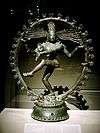Vijñāna Bhairava Tantra
| Part of a series on |
| Hindu scriptures and texts |
|---|
 |
|
Rig vedic
Sama vedic Yajur vedic Atharva vedic |
|
Other scriptures |
| Related Hindu texts |
|
|
|
Timeline |
| Part of a series on | ||
| Hindu philosophy | ||
|---|---|---|
 | ||
| Orthodox | ||
|
|
||
| Heterodox | ||
|
|
||
|
||
The Vijñāna Bhairava Tantra (sometimes spelled in a Hindicised way as Vigyan Bhairav Tantra) is a key text of the Trika school of Kashmir Shaivism in Sanskrit language. Cast as a discourse between the god Shiva and his consort Devi or Shakti, it briefly presents 112 meditation methods or centering techniques (dharana).[1] These include several variants of breath awareness, concentration on various centers in the body, non-dual awareness, chanting, imagination and visualization and contemplation through each of the senses.[2] A prerequisite to success in any of the 112 practices is a clear understanding of which method is most suitable to the practitioner.[3]
The text
The text is a chapter from the Rudrayamala Tantra, a Bhairava Agama. Devi, the goddess, asks Shiva to reveal the essence of the way to realization of the highest reality. In his answer Shiva describes 112 ways to enter into the universal and transcendental state of consciousness. References to it appear throughout the literature of Kashmir Shaivism, indicating that it was considered to be an important text in the monistic school of Kashmir Shaiva philosophy.
Commentaries and translations
The text appeared in 1918 in the Kashmir Series of Text and Studies (KSTS).[4] The Kashmir Series published two volumes, one with a commentary in Sanskrit by Kshemaraja and Shivopadhyaya and the other with a commentary, called Kaumadi, by Ananda Bhatta.
In 1957, Paul Reps brought the text to wide attention by including an English translation in his popular book Zen Flesh, Zen Bones. Reps' translation was the subject of a voluminous commentary by Osho.
Several other translations and commentaries have since become available.
References
- ↑ Paul Reps, Zen Flesh, Zen Bones, A Collection of Zen and Pre-Zen Writings (ISBN 0-8048-0644-6)
- ↑ Osho, The Book of the Secrets, vols. 1-5, St. Martin's Griffin, 1998, ISBN 0-312-18058-6, ISBN 978-0-312-18058-4
- ↑ Vijnana Bhairava – The Manual for Self Realization, ed. John Hughes. Contents pp. vii-xi.
- ↑ "Muktabodha Institute". Retrieved 2008-02-16.
